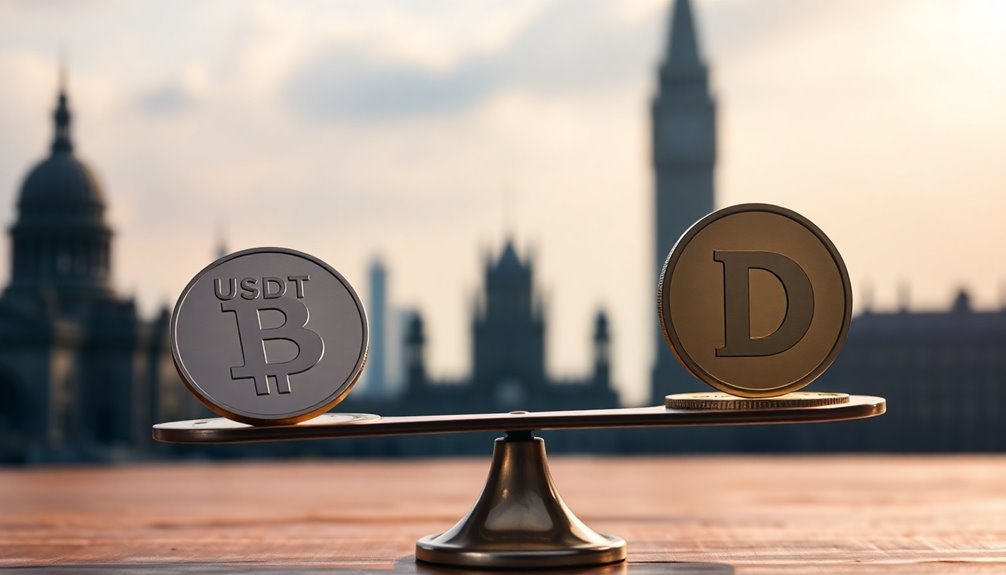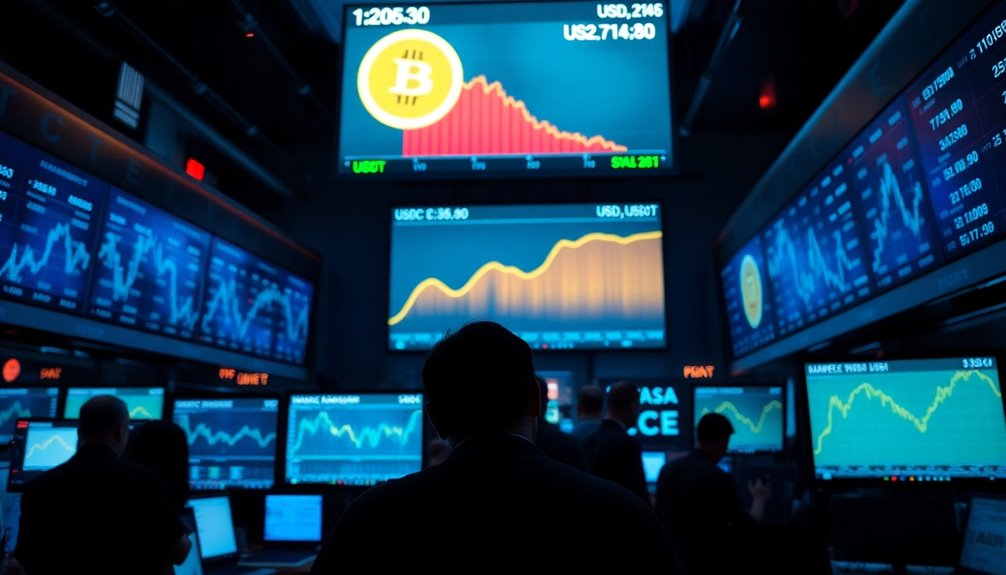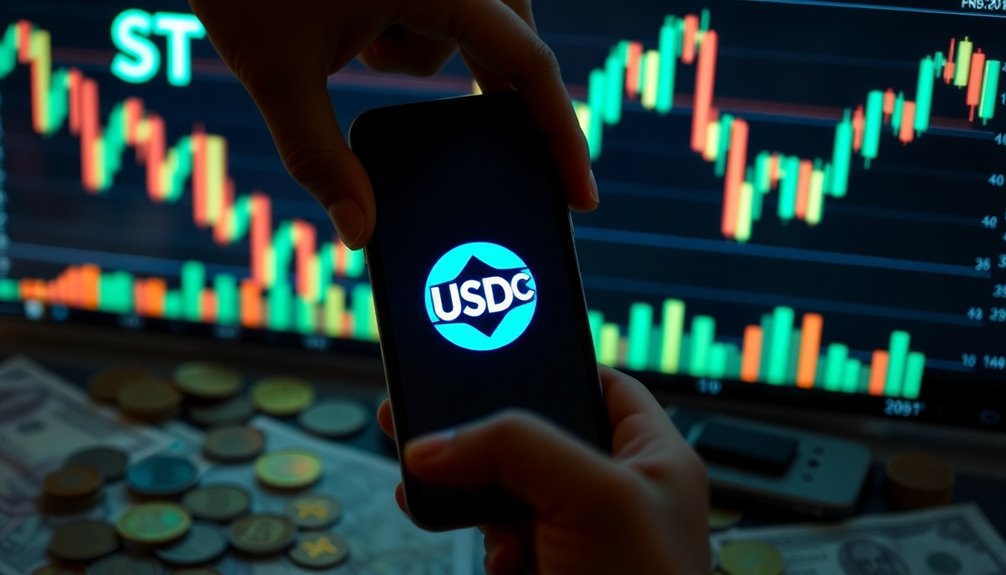USDT's position is indeed at risk with the upcoming MiCA regulations set to take effect. These rules are increasing scrutiny on non-compliant stablecoins, prompting users to shift towards safer options like USDC, which now holds nearly 14% of the market. USDT has faced significant challenges, including delistings from major European exchanges and a drop in its market cap by $7 billion. As demand rises for compliant alternatives, USDC's trading volume has surged, reshaping the competitive landscape. To understand more about these market shifts and their implications, there's plenty more to uncover.
Regulatory Changes Impact Stablecoins

As regulatory changes sweep through the financial landscape, stablecoins are facing significant challenges and opportunities.
The implementation of the MiCA regulation in the EU on June 30, 2024, has created a stringent compliance environment for stablecoin issuers. This shift has heightened demand for compliant stablecoins like Circle's USDC and EURC, with USDC's trading volume hitting a staggering $23 billion weekly. This positions USDC with nearly 14% of the stablecoin market share, closely rivaling Hong Kong's FDUSD. Meanwhile, uncertainty looms for non-MiCA authorized stablecoins, especially concerning their future trading under upcoming CASP provisions. Additionally, the anticipated growth in stablecoin adoption due to regulatory support is likely to further influence the competitive landscape among stablecoins.
As the landscape evolves, you'll want to keep an eye on how these regulatory changes reshape the stablecoin market and influence adoption.
Regulatory Scrutiny Intensifies on USDT

With regulatory scrutiny tightening around stablecoins, USDT finds itself in a precarious position.
It's been delisted from major European exchanges like Bitstamp and Kraken due to non-compliance with MiCA regulations, leading to a staggering $7 billion drop in market capitalization.
Tether struggles to meet EU requirements, which mandate that at least 60% of reserves be held in recognized banks. Additionally, the overall market cap for stablecoins has surged to $500 billion(500 billion), further intensifying the competition for USDT. This surge is fueled by the growing interest in alternative investments(alternative investments) amid market volatility.
As nearly $4 billion worth of USDT was redeemed ahead of MiCA’s enforcement, concerns over legal risks and operational uncertainties mount. Market observers are closely monitoring the effects of these redemptions on liquidity and potential volatility within the crypto space. Additionally, the recent surge in whale investment in wpepe has drawn attention, as large holders seek to capitalize on emerging opportunities amidst regulatory changes. This shift in investment strategy underscores the evolving dynamics of the market as stakeholders adapt to the new regulatory landscape.
Transparency issues further complicate matters, as Tether's past settlement with the CFTC and ongoing accusations of under-collateralization erode investor trust.
This growing scrutiny could jeopardize USDT's standing in the competitive stablecoin landscape.
Stablecoin Supply and Demand Dynamics

As of January 2025, the stablecoin market cap reached $189.1 billion, with a notable supply increase of 16.9% in late 2024. Tether (USDT) still leads, but USDC is rapidly gaining ground, growing by $954 million recently. The MiCA regulations are impacting liquidity, particularly for USDT in Europe, pushing investors toward more compliant options like USDC and FDUSD. With reduced speculative demand and increased interest in safer investments, the market's stabilization suggests a shift in focus. This trend is further reinforced by the fact that stablecoin supply increased by $14.68 billion during the previous rally, highlighting the demand for stable assets. Understanding these dynamics is crucial for navigating the evolving stablecoin landscape and leveraging opportunities effectively.
Corporate Treasury Diversification Strategies

Effective corporate treasury diversification strategies are essential for managing risk and optimizing returns. By spreading your assets across different currencies, financial institutions, and instruments, you can significantly mitigate risk. This approach also enhances liquidity, ensuring you can meet short-term obligations without delay. With a diversified portfolio, you gain operational flexibility, allowing quick responses to the needs of various stakeholders. Moreover, a well-executed strategy can yield higher returns by capitalizing on interest rate differences. Incorporating money market funds can further bolster your diversification, offering daily liquidity and counteracting counterparty risk. Additionally, diversification reduces counterparty risk while maintaining liquidity. Regular portfolio reviews and rebalancing keep your investments aligned with your risk tolerance, enabling you to seize growth opportunities effectively.
Election Cycles Affect Cryptocurrency Markets

As election cycles unfold, they can significantly influence cryptocurrency markets, often leading to notable trends and shifts in investor behavior.
Historically, post-election periods have sparked impressive growth in crypto investments, with Bitcoin skyrocketing from $66,000 to over $89,000 just after the 2024 election. Similarly, Ethereum jumped from $383 to $4,588. The historical data indicates robust returns for major cryptocurrencies during these times.
The clarity elections provide reduces uncertainty, boosting investor confidence and generating market optimism. New leadership often reshapes regulatory landscapes, with presidential appointments impacting bodies like the SEC and CFTC.
While excitement grows, remember that volatility remains a constant in crypto. Despite historical gains, unpredictable events can still lead to significant market fluctuations, emphasizing the need for caution in your investment strategies.
Market Adaptation Post-Regulation

While the introduction of new regulations might seem daunting, it actually offers a unique opportunity for the cryptocurrency market to adapt and grow. You'll find that clearer guidelines under MiCA enhance transparency and compliance, especially for stablecoin issuers. USDC stands out as it's already aligned with these standards, backed by thorough audits. With regulatory frameworks promoting innovation and competition, businesses may shift towards USDC, especially if USDT faces restrictions. Moreover, heightened risk management practices, like stringent cybersecurity and AML regulations, will bolster market integrity. As international cooperation flourishes, you'll witness a more stable and transparent digital asset landscape, empowering consumers and ensuring they're well-informed about their investments. Additionally, SEC regulations could legitimize cryptocurrency enterprises, attracting traditional investors and fostering innovation. Embracing these changes could lead to a more robust crypto market. Furthermore, the integration of AI-driven technologies is expected to enhance security measures, making digital transactions more secure and efficient.
Frequently Asked Questions
What Is the Difference Between USDT and USDC?
USDT and USDC are both stablecoins, but they differ significantly.
USDT has a larger market cap and higher circulating supply, reflecting its longer presence in the market. However, USDC is known for its transparency and regulatory compliance, providing regular audits of its reserves.
While USDT is widely adopted globally, USDC is gaining traction, particularly among institutions in the U.S.
Both aim to maintain a peg to the US dollar, yet their approaches vary.
How Does Mica Impact Cryptocurrency Exchanges?
Did you know that over 90% of crypto exchanges are now prioritizing compliance?
MiCA significantly impacts cryptocurrency exchanges by enforcing strict licensing and operational standards. You'll need to secure authorization from national authorities and comply with governance measures.
Additionally, MiCA's market abuse prevention rules demand transparency, deterring insider trading and price manipulation.
As a result, you can expect enhanced consumer protection and a more regulated trading environment, boosting overall market integrity.
Are There Alternatives to USDT and USDC?
Yes, there are several alternatives to USDT and USDC.
You can consider USD Coin (USDC), which offers regulatory compliance and is backed by reserves.
Paxos Standard (PAX) also provides transparency and stability with 1:1 backing.
Dai (DAI) uses algorithmic stability and decentralized governance, while Binance USD (BUSD) is gaining traction among users.
Each of these options presents unique features, so it's worth exploring them to find what suits your needs best.
What Risks Do Investors Face With Stablecoins?
Imagine holding a dollar that could suddenly lose its value overnight.
That's the risk investors face with stablecoins.
You've got redemption risks, where you might struggle to cash out during market chaos.
Cyber-attacks can compromise your assets, and if a third-party issuer goes under, your investment might vanish.
Plus, depegging events could erase your expected value, shaking your confidence.
Always weigh these risks before diving into the stablecoin market.
How Do Interest Rates Affect Stablecoin Investments?
Interest rates significantly impact your stablecoin investments.
When rates drop, issuers earn less interest income, potentially prompting them to seek riskier assets for better returns. This shift can affect the stability of your investments.
Lower yields may lead to increased volatility, making your stablecoin holdings riskier.
Additionally, regulatory changes may influence how issuers manage their reserves, further affecting your investment's performance and stability in the market.
Stay informed about these dynamics.
Conclusion
As the regulatory storm clouds gather, USDT's stronghold feels increasingly precarious. Picture a bustling marketplace where USDC, like a rising sun, casts a longer shadow, drawing in wary traders seeking stability. With every new rule and shifting demand, the landscape of stablecoins evolves, urging you to stay vigilant. Embrace the winds of change, and keep your eyes peeled—this fluid environment promises both challenges and opportunities for those ready to navigate its currents.









